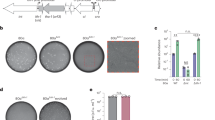Abstract
SCHISTOSOMIASIS (bilharzia) is a parasitic disease caused by several species of schistosome worms (blood flukes). The key pathogenic event in this disease is the formation of granulomas around schistosome eggs trapped in portal venules of the liver1–9. Granulomas are a distinctive form of chronic inflammation characterized by localized aggregation of activated macrophages around an inciting stimulus10. Each granuloma evolves to form a fibrous scar; in schistosomiasis, the result is widespread hepatic fibrosis and portal hypertension. To identify the specific immune signal molecules necessary for granuloma formation, we studied schistosome infections in severe combined immunodeficient (SCID) mice, which have normal macrophages but lack functional B or T lymphocytes11,12. Here we report that the immunoregulatory cytokine tumour necrosis factor α is necessary and sufficient to reconstitute granuloma formation in schistosome-infected SCID mice. Moreover, we find that the parasitic worms require tumour necrosis factor α for egg-laying and for excretion of eggs from the host. The implication of this latter result is that the parasite has adapted so successfully to its host that it uses a host-derived immuno-regulatory protein as a signal for replication and transmission.
This is a preview of subscription content, access via your institution
Access options
Subscribe to this journal
Receive 51 print issues and online access
$199.00 per year
only $3.90 per issue
Buy this article
- Purchase on Springer Link
- Instant access to full article PDF
Prices may be subject to local taxes which are calculated during checkout
Similar content being viewed by others
References
Warren, K. S., Domingo, E. O. & Cowan, R. B. T. Am. J. Path. 51, 735–756 (1967).
Phillips, S. M. & Colley, D. G. Prog. Allergy 24, 49–182 (1978).
Doughty, B. L. & Phillips, S. M. J. Immun. 128, 37–42 (1982).
Prakash, S., Postlethwaite, A. E., Stricklin, G. P. & Wyler, D. J. J. Immun. 144, 317–322 (1990).
Olds, G. R. & Kresina, T. F. J. infect. Dis. 159, 798–801 (1989).
Byram, J. E. & von Lichtenberg, F. Am. J. trop. Med. Hyg. 26, 944–955 (1977).
Cheever, A. W., Byram, J. E. & von Lichtenberg, F. Parasite Immun. 7, 387–398 (1985).
Cheever, A. W., Deb, S. & Duvall, R. H. Am. J. trop. Med. Hyg. 40, 66–71 (1989).
Mathew, R. C. & Boros, D. L. Infect. Immunity. 54, 820–826 (1986).
Robbins, S. L., Cotran, R. S. & Kumar, V. Pathologic Basis of Disease 64–65 (Saunders, Philadelphia, 1984).
Bosma, G. C., Custer, R. P. & Bosma, M. J. Nature 301, 527–530 (1983).
Custer, R. P., Bosma, G. C. & Bosma, M. J. Am. J. Path. 120, 464–477 (1985).
Pearce, E. J., Caspar, P., Grzych, J. M., Lewis, F. A. & Sher, A. J. exp. Med. 173, 159–166 (1991).
Grzych, J. M. et al. Immun. 146, 1322–1327 (1991).
McGee, H. J., Long, S. R. & Briggs, W. R. Nature 308, 667–668 (1984).
Kaye, J. & Janeway, C. A. J. exp. Med. 159, 1397–1412 (1984).
Chensue, S. W., Otterness, I. G., Higashi, G. I., Forsch, C. S. & Kunkel, S. L. J. Immun. 142, 1281–1286 (1989).
Kindler, V., Sappino, A.-P., Grau, G. E., Piguet, P.-F. & Vassalli, P. Cell 56, 731–740 (1989).
Jäätelä, M. Lab. Invest. 64, 724–742 (1991).
Piguet, P. F., Collart, M. A., Grau, G. E., Sappino, A.-P. & Vassalli, P. Nature 344, 245–247 (1990).
Byram, J. E., Doenhoff, M. J., Musallam, R., Brink, L. H. & von Lichtenberg, F. Am. J. trop. Med. Hyg. 28, 274–285 (1979).
Doenhoff, M. J., Dunne, D. W., Bain, J., Lillywhite, J. E. & McLaren, M. L. Devl. Biol. Standard. 62, 63–73 (1985).
Perrin, P. J. & Phillips, S. M. J. Immun. 141, 1714–1719 (1988).
Doenhoff, M. J., Hassounah, O. & Murare, H. Trans. R. Soc. trop. Med. Hyg. 80, 503–514 (1986).
Duvall, R. H. & DeWitt, W. B. Am. J. trop. Med. Hyg. 16, 483–486 (1967).
Cheever, A. W., Deb, S. & Duvall, R. H. Am. J. trop. Med. Hyg. 40, 66–71 (1989).
Basch, P. F. J. Parasit. 67, 179–185 (1981).
Author information
Authors and Affiliations
Rights and permissions
About this article
Cite this article
Amiri, P., Locksley, R., Parslow, T. et al. Tumour necrosis factor α restores granulomas and induces parasite egg-laying in schistosome-infected SCID mice. Nature 356, 604–607 (1992). https://doi.org/10.1038/356604a0
Received:
Accepted:
Issue Date:
DOI: https://doi.org/10.1038/356604a0
Comments
By submitting a comment you agree to abide by our Terms and Community Guidelines. If you find something abusive or that does not comply with our terms or guidelines please flag it as inappropriate.



